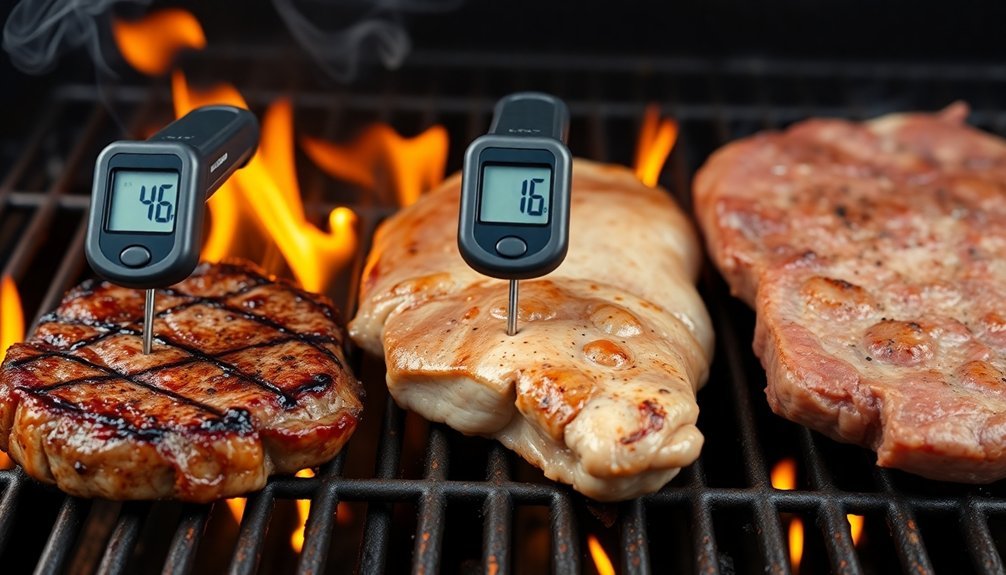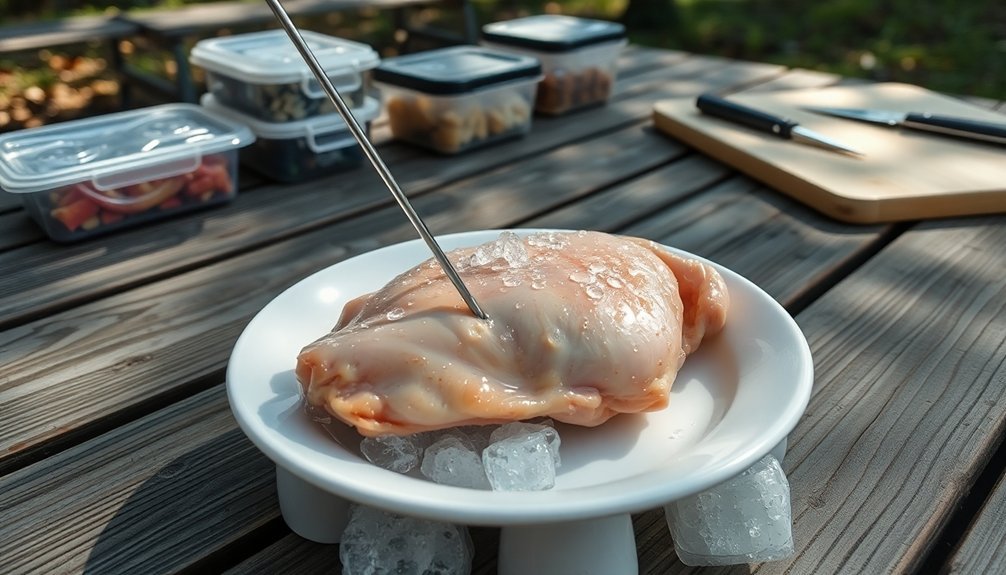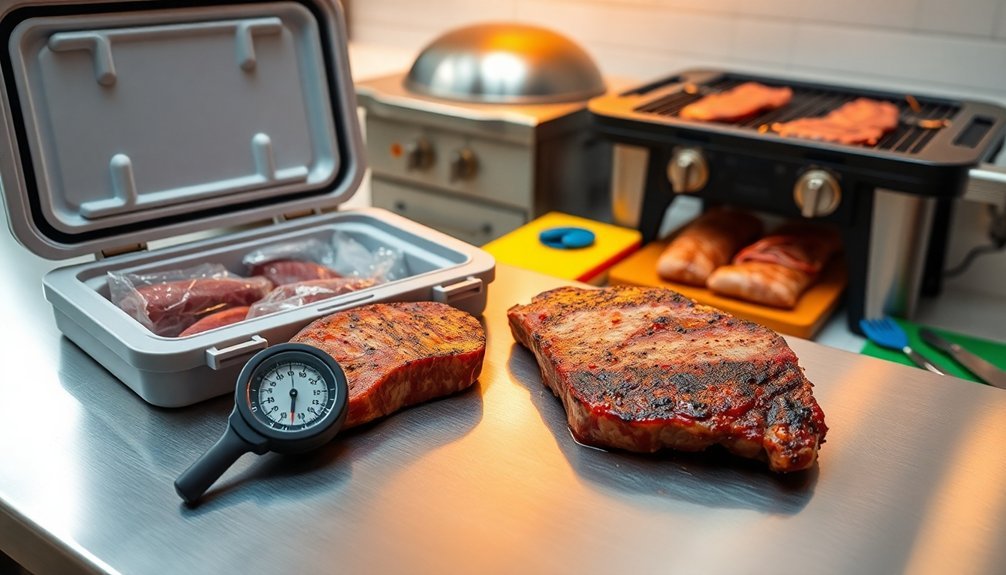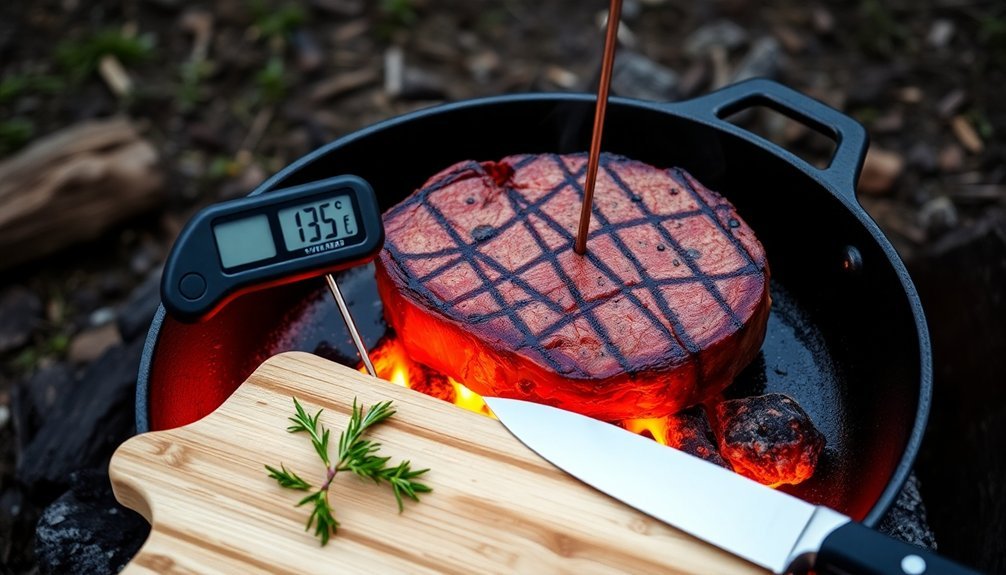To safely cook meat outdoors, you'll need to master five critical techniques. Always use a meat thermometer to verify proper internal temperatures: 160°F for ground meats, 165°F for poultry, and 145°F for medium-rare steaks. Prevent cross-contamination by using separate plates and utensils for raw and cooked foods. Thaw meats properly using refrigerator, cold water, or microwave methods. Keep your grill and equipment clean with regular maintenance and proper cleaning solutions. Store foods at safe temperatures, keeping cold items below 40°F and hot foods above 140°F. These foundational practices will help you become a safer, more confident outdoor chef.
Temperature Control For Different Meats

Mastering temperature control is essential for safe and delicious outdoor cooking. You'll need to hit specific internal temperatures for each type of meat: 160°F for ground meats, 165°F for chicken and poultry, and 145°F for medium-rare steaks.
When checking temperatures, insert your thermometer into the thickest part of the meat, avoiding bone, fat, or gristle. For whole poultry, place it in the inner thigh area. Direct heat methods work best for quickly achieving proper temperatures in burgers and steaks.
Remember to factor in carryover cooking by removing meats 5-10°F below your target temperature. You'll want to let steaks rest for four minutes and poultry for three minutes after cooking.
Don't forget to calibrate your thermometer for accuracy. Using digital probes or continuous monitoring devices like UltraQ can help you maintain precise temperature control throughout the cooking process.
Preventing Cross-Contamination While Grilling
While everyone loves a great barbecue, preventing cross-contamination is essential for keeping your outdoor cooking safe.
You'll need to maintain strict separation between raw and cooked foods by using different plates, utensils, and cutting boards. Don't reuse marinades that have touched raw meat unless you boil them first, and always keep a separate brush for basting cooked foods. Regular grill cleaning helps eliminate harmful bacteria that could contaminate your food.
Remember to wash your hands thoroughly with soap for 20 seconds when switching between handling different foods.
- Don't risk making your family sick by using the same plate for raw and cooked meats
- Keep your loved ones safe by maintaining separate utensils for raw and ready-to-eat foods
- Protect your guests by storing marinades properly in the refrigerator
- Show you care by cleaning your grill thoroughly before the season starts
- Guarantee everyone's safety by using fresh, clean plates for serving cooked foods
Safe Meat Thawing Methods

Because proper thawing is essential for food safety, you'll need to understand the three approved methods: refrigerator, cold water, and microwave thawing.
For refrigerator thawing, place your meat on a bottom shelf, using a plate to catch drips. Allow 24 hours for every 5 pounds. This method's safe enough that you can refreeze the meat if needed.
When using cold water, seal your meat in a watertight bag and submerge it completely. You'll need to change the water every 30 minutes, with most cuts thawing within 1-3 hours. Immediate cooking is required after using this method to ensure food safety precautions.
For microwave thawing, use a covered microwave-safe container and follow your unit's defrost settings. Plan on 10-15 minutes per pound.
Clean Equipment Management
To maintain a safe outdoor cooking environment, proper equipment cleaning and maintenance must become part of your routine.
You'll need to regularly wipe down all surfaces with mild detergent and warm water, using non-abrasive materials to protect finishes. For your grill, use a specialized degreaser, followed by a vinegar and baking soda mixture to dissolve stubborn grease.
Don't forget to inspect gas lines and electrical components for damage, and protect your equipment from harsh weather with appropriate covers.
- Your family's health depends on your commitment to equipment cleanliness
- Every thorough cleaning protects your investment in outdoor cooking
- A well-maintained grill delivers consistently delicious results
- Clean equipment prevents dangerous grease fires
- Regular maintenance extends the life of your outdoor kitchen, creating lasting memories
Proper Food Storage Guidelines

Safe outdoor cooking begins with four essential food storage principles: temperature control, time management, container selection, and contamination prevention.
You'll need to keep cold foods at or below 40°F using coolers with ice packs, while hot foods must stay above 140°F in insulated containers.
Don't let any food sit in the danger zone between these temperatures for more than 2 hours, or 1 hour if it's above 90°F outside. Store your beverages in a separate cooler to maintain consistent temperatures for perishables.
To prevent cross-contamination, you should use different utensils and containers for raw and cooked meats.
Don't reuse marinades that have touched raw meat, and always transfer cooked food to clean plates.
Pack food in shallow containers for quicker cooling and better temperature control.
Frequently Asked Questions
How Do I Adjust Grilling Time When Cooking Multiple Types of Meat Simultaneously?
Start with longer-cooking meats first, then add quicker-cooking items later. You'll need to track each meat's cooking time separately and use temperature zones to keep finished pieces warm while others cook.
What Should I Do if Unexpected Rain Occurs During a BBQ Session?
If you're using a gas or charcoal grill, keep the lid closed and move under a shelter. Don't use electric grills in rain. Consider setting up a canopy, but make certain it's high enough to avoid heat damage.
Can I Use Wood Chips From My Backyard Trees for Smoking Meat?
You shouldn't use random backyard wood for smoking meat. Only use known hardwoods like oak, hickory, or fruitwoods. Backyard trees could be unsafe species or chemically treated, risking your health when smoking.
How Do I Maintain Proper Airflow When Grilling in Windy Conditions?
Position your grill perpendicular to the wind, use windscreens, and adjust vents away from wind direction. You'll need extra charcoal for charcoal grills, and don't forget to secure the grill to prevent movement.
When Should I Replace My Grill's Metal Grates for Food Safety?
You'll need to replace your grill grates when you notice deep, persistent rust, significant chipping, or uneven surfaces. Don't wait if you see flaking metal, as rust particles can contaminate your food.
In Summary
You'll prevent foodborne illness and enjoy delicious outdoor-cooked meats by following these essential safety guidelines. Remember to monitor temperatures carefully, keep raw and cooked foods separate, thaw meat properly, maintain clean equipment, and store everything at appropriate temperatures. Don't skip these vital steps – they're your key to successful and safe outdoor cooking. Your family and guests will appreciate your attention to food safety.





Leave a Reply